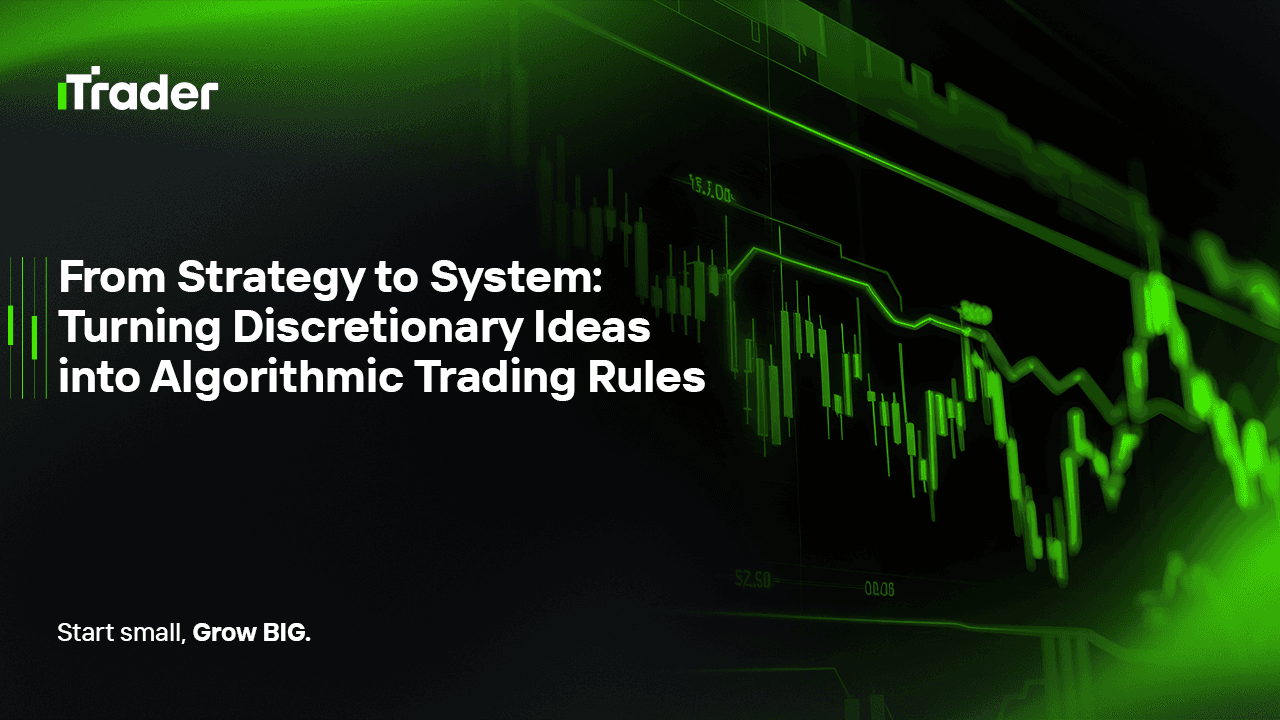2025-09-25
Most traders begin their journey by trading discretionary — relying on their eyes, instincts, and past experience to make decisions in the moment. There’s nothing wrong with that. In fact, many great insights are born from seeing patterns on a chart and trusting your gut.
But there’s a problem. Intuition doesn’t scale. It can’t be backtested. And when pressure mounts — especially under prop firm evaluation rules — emotions creep in, decisions change, and discipline slips.

That’s why serious traders eventually take the step from strategy to system: transforming their discretionary ideas into clear, testable, rule-based frameworks. In this article, we’ll look at how to make that shift, why it matters in the prop trading world, and what tools you can use to bring your trading to the next level.
Discretionary trading means you’re calling the shots in real time. You spot a pattern, read price action, maybe factor in the news, and decide: “This looks like a good entry.”
Systematic trading, on the other hand, is built on rules. Every trade follows predefined conditions, which means the strategy can be tested, measured, and even automated.
For prop firm traders, systematic approaches are a necessity. Firms don’t just care about making money — they care about risk control, discipline, and repeatability. A system gives you all three.
Every discretionary decision has hidden logic behind it. Maybe you saw price “reject” a level. Maybe you noticed momentum fading before a breakout. The key is to translate those observations into conditions that can be measured.
Example:
It’s the same insight — but expressed in a way that can be tested, repeated, and tracked.
To turn an idea into a system, think in components:
Each rule removes uncertainty and brings structure to your trading.
Once your rules are clear, they need proof.
A system isn’t proven until it survives both.
Not every trader wants to hand over all decisions to an algorithm. That’s fine. Many successful prop traders use hybrid systems:
This balance keeps discipline in place while still allowing for human judgment when it matters most.
Prop firms are strict about rules: daily loss limits, maximum drawdowns, position sizing caps. Without a system, it’s easy to break those rules accidentally. With one, you stay in line by default.
More importantly, systems deliver what prop firms value:
Turning ideas into systems is easier than ever:
You don’t need to be a programmer to start. Even partial rule-building makes your trading more disciplined.
Moving from discretionary trading to rule-based systems isn’t about losing creativity — it’s about bottling your insights into something repeatable.
The steps are simple:
The truth is this: good traders rely on instinct, but great traders systematize their instincts into rules that work under pressure. That’s the difference between passing a prop firm challenge and building a career in trading.
© 2025 iTrader Global Limited | 公司注册号 15962
iTrader Global Limited 位于科摩罗联盟安儒昂自治岛穆察姆杜 Hamchako,并受科摩罗证券委员会(Securities Commission of the Comoros)许可及监管。我们的牌照号为 L15962/ITGL。
iTrader Global Limited 以“iTrader”作为交易名称,获授权从事外汇交易业务。公司的标志、商标及网站均为 iTrader Global Limited 的专属财产。
风险提示: 差价合约(CFD)交易因杠杆作用存在高风险,可能导致资金快速亏损,并非适合所有投资者。
交易资金、差价合约及其他高杠杆产品需要具备专业知识。
研究显示,84.01% 使用杠杆的交易者会遭受亏损。请务必充分了解相关风险,并确认在交易前已做好承担资金损失的准备。
iTrader 特此声明,不会对任何个人或法人在杠杆交易中产生的风险、亏损或其他损失承担全部责任。
本网站提供的新闻及信息仅用于教育目的。用户应独立且审慎地作出金融决策。
限制条款: iTrader 不会向法律、法规或政策禁止此类活动的国家或地区居民提供本网站或相关服务。若您居住在限制使用本网站或服务的司法管辖区,您有责任确保遵守当地法律。iTrader 不保证其网站内容在所有司法管辖区均适用或合法。
iTrader Global Limited 不向以下国家/地区的公民提供服务,包括但不限于:美国、巴西、加拿大、以色列及伊朗。